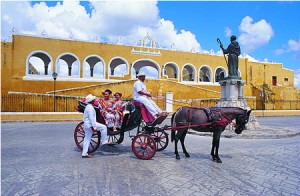 Izamal is a small colonial population in the state of Yucatan. It is named for the Mayan and means “dew of heaven”, it is located just 72 kilometers from Merida. It is known as the “city of three cultures”, since it combines features of its pre-Hispanic past, of the colonial period and modern times, also it has been called the “Yellow City” because most of their buildings are painted in this color. The city has been chosen as a “Magic Town”. In the city of Izamal, as in many towns of the Yucatan, the Mayan language is still spoken by most of its inhabitants.
Izamal is a small colonial population in the state of Yucatan. It is named for the Mayan and means “dew of heaven”, it is located just 72 kilometers from Merida. It is known as the “city of three cultures”, since it combines features of its pre-Hispanic past, of the colonial period and modern times, also it has been called the “Yellow City” because most of their buildings are painted in this color. The city has been chosen as a “Magic Town”. In the city of Izamal, as in many towns of the Yucatan, the Mayan language is still spoken by most of its inhabitants.
Izamal was one of the most important sites of Mayan civilization, a large settlement on the plains of the northern Yucatán Peninsula. The size of its buildings and network of pathways called ‘sacbes’ (white road built in the ancient Maya) are evidence of the religious, political and economic power that the city had over the vast territory of the Mayab.
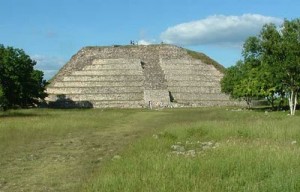 The pyramid known as Kinich Kakmó is visible at a considerable distance from all directions. It is a structure of ten levels dedicated to the Mayan sun god, built atop a huge base. To the southeast there is another large pyramid called Itzamatul. The southwest side of the central square is bounded by another pyramid known as TokHun Pik and in the west the public space is closed with the temple of Kabul. In the center of Izamal, in the place where today stands the Franciscan convent was the pyramid Pap Hol Chack.
The pyramid known as Kinich Kakmó is visible at a considerable distance from all directions. It is a structure of ten levels dedicated to the Mayan sun god, built atop a huge base. To the southeast there is another large pyramid called Itzamatul. The southwest side of the central square is bounded by another pyramid known as TokHun Pik and in the west the public space is closed with the temple of Kabul. In the center of Izamal, in the place where today stands the Franciscan convent was the pyramid Pap Hol Chack.
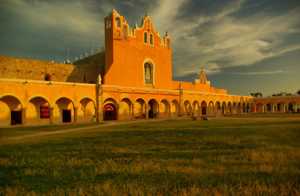 In the sixteenth century Spanish conquerors built a Christian temple atop a large pyramid and a Franciscan monastery with the name of San Antonio de Padua using materials of one of the five Great Pyramids.
In the sixteenth century Spanish conquerors built a Christian temple atop a large pyramid and a Franciscan monastery with the name of San Antonio de Padua using materials of one of the five Great Pyramids.
Finished in 1561, the atrium is the second largest in the world; it has a corridor with 75 arches around the esplanade of 7.806 sq meters. It has become a tourist attraction because in the evenings there is a sound and light show which enhances the origins of this Mayan city.
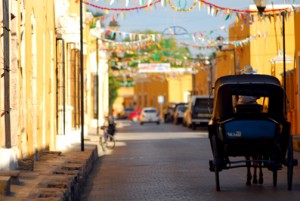 The city of Izamal has become a major tourist destination that attracts the visitor for its beauty, its squares and streets, as well as the pre-Hispanic ruins and the beautiful convent. One can enjoy a walk on cobblestone streets, where there are no electrical cables and the lamps are classical lanterns. In the square are numerous carriages which are the way of transport for many locals, This square is also the epicenter for visiting villages, beaches, cenotes and haciendas in the region, and Mérida itself.
The city of Izamal has become a major tourist destination that attracts the visitor for its beauty, its squares and streets, as well as the pre-Hispanic ruins and the beautiful convent. One can enjoy a walk on cobblestone streets, where there are no electrical cables and the lamps are classical lanterns. In the square are numerous carriages which are the way of transport for many locals, This square is also the epicenter for visiting villages, beaches, cenotes and haciendas in the region, and Mérida itself.
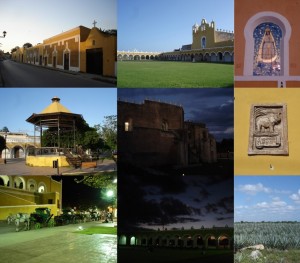 In the city hall the visitor can see a scale model of the entire town, the parks, the archaeological zone, among other attractions. Many Mayan ruins are in the courtyards of the houses and cannot be visit, but in this scale model one can get an idea of how many.
In the city hall the visitor can see a scale model of the entire town, the parks, the archaeological zone, among other attractions. Many Mayan ruins are in the courtyards of the houses and cannot be visit, but in this scale model one can get an idea of how many.
Tourists can also enjoy a wide range of crafts, ranging from jewelry, leather and hammocks to works in pottery and wood crafts. There is also a distillery that processes extract agave, henequen producing liquor, also called “water of life”, similar to tequila or mezcal, and sold under the name “Izamal”.
